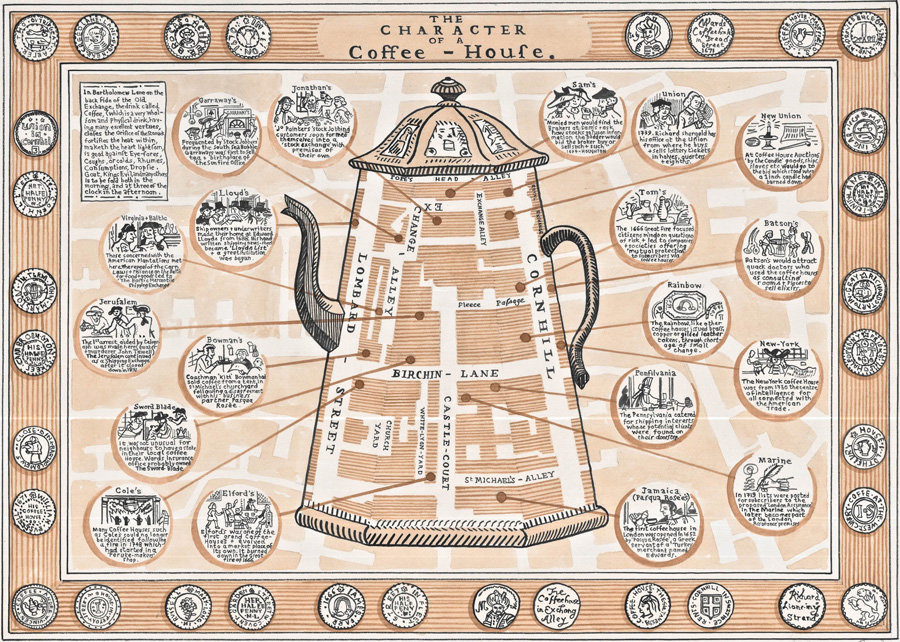
Ephemera
Coffee Culture
The site of England’s first coffee house: St Michaels Alley, Cornhill, City, London, currently serving as a pub.
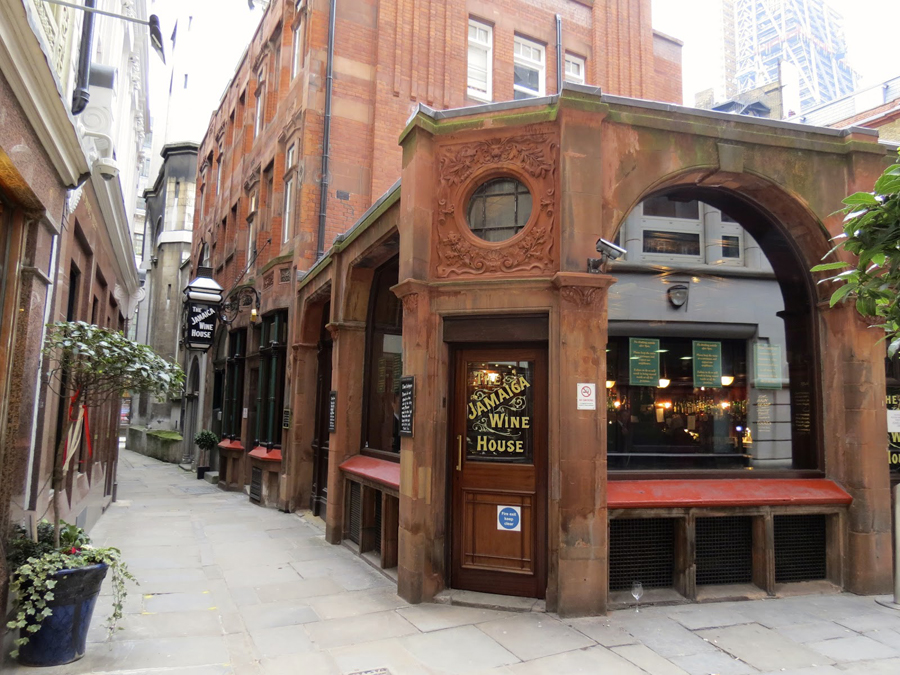
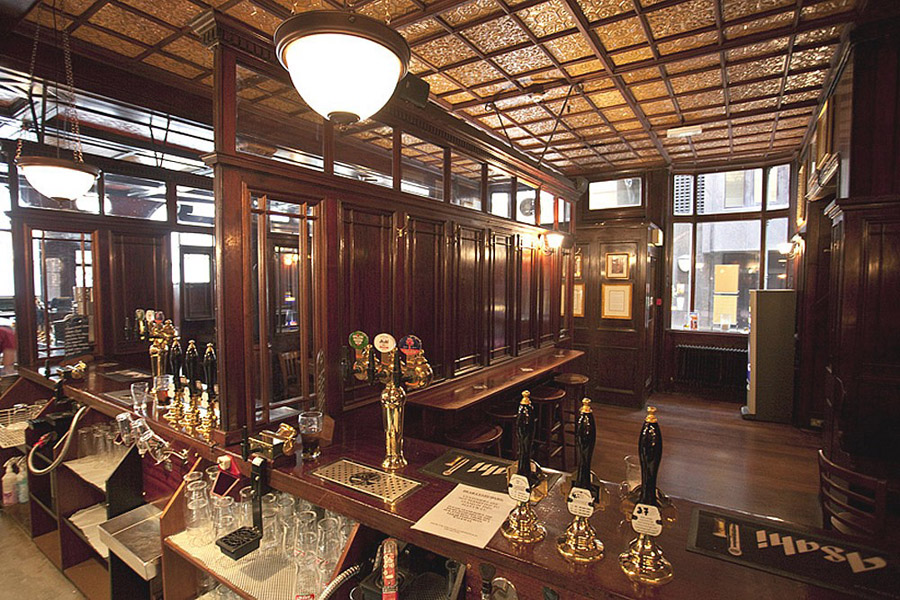
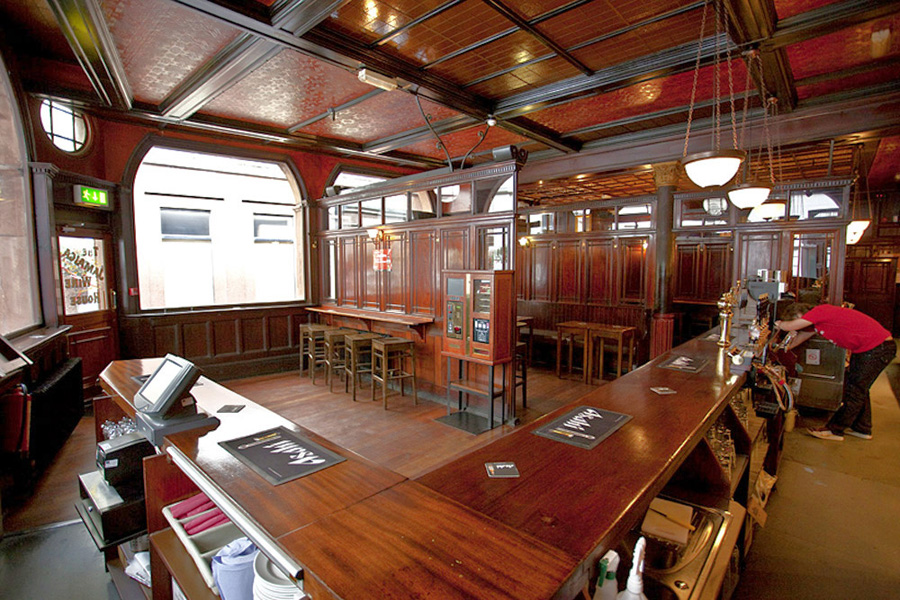
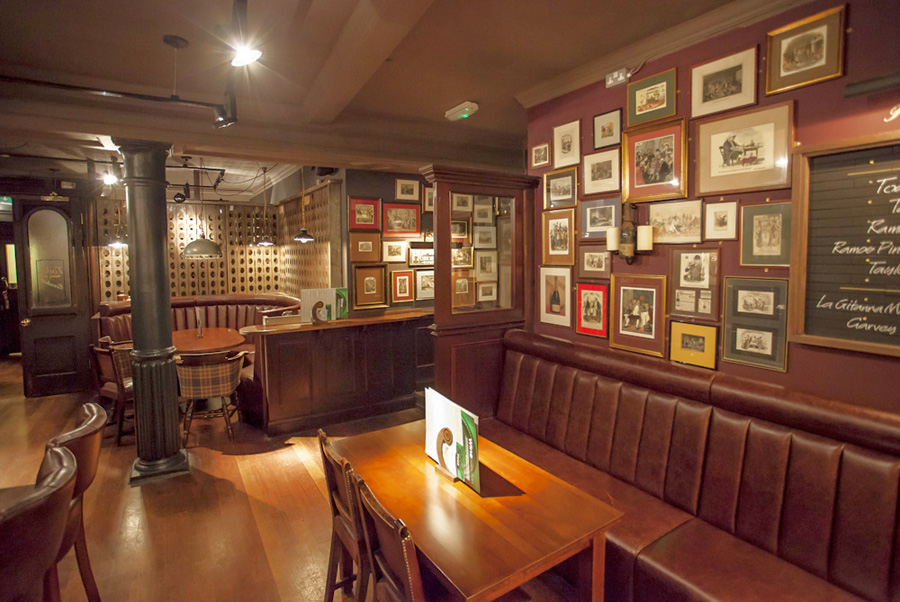
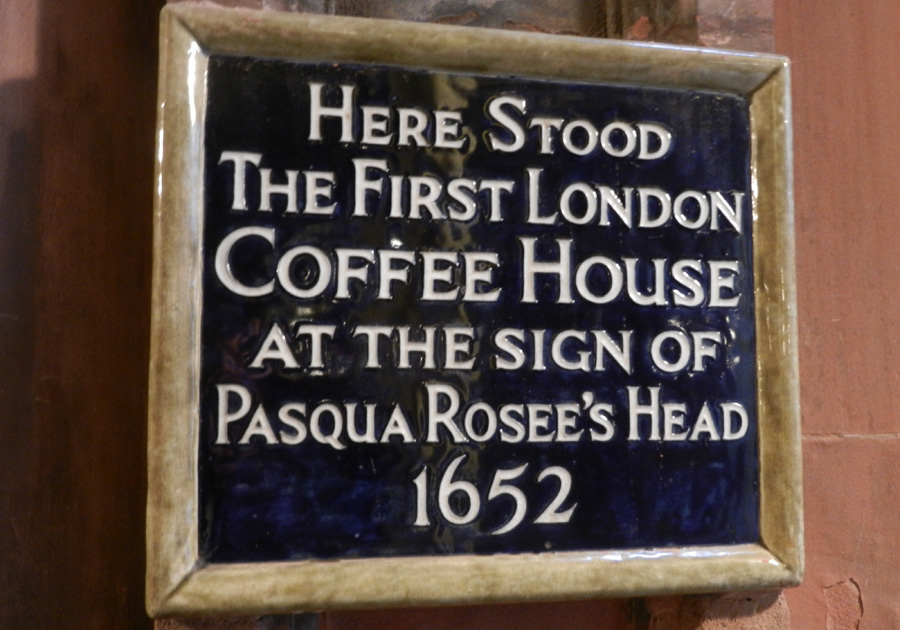
There is an intriguing layout, which is not known to survive anywhere else. The rectangular space is divided up into four by three screens set at right angles to the counter. Originally there would have been no link between the two left-hand and the two right-hand compartments. The distinction between the two parts is emphasised by completely different ceiling treatments: that on the left, unusually, has panels of ceramic or enamelled metal. It is almost as though the pub was built in two stages but there is no evidence of this in the fabric of the building. The screens themselves are fine pieces of mahogany woodwork, decorated with square panels and some glazed parts. The counter is original but has been altered in the right-hand area. The bar-back and seating are modern.
This was the site of England’s first coffee house, established by a ‘Turk’ (in different sources referred as a Greek or Armenian from Turkey), Pasqua Rosee, and in existence by 1654. Coffee houses played an important part in the social and business lives of the country’s better-off urban population in the 18th century. This one became the Jamaica Coffee House in 1674, changing into a wine house in 1869.
Pasqua Rosée born in the maritime Republic of Ragusa was formerly the servant of one Daniel Edwards, a Levant Company merchant in Smyrna. Edwards traded in the Middle East, and while there had developed a taste for this exciting Arabic drink. He assisted Rosée both financially and practically in setting up the business. However he seems to have soon fallen out with Mr Edwards and teaming up with his former employer’s coachman, they established a coffee-house in St Michael’s Alley. The first coffee house in London (by some accounts the first in Britain had opened two years previously in Oxford*) was an instant success. Firstly, because this was Cromwell’s Britain, where alchohol was strongly discouraged – coffee was seen as a more respectable alternative and therefore to be encouraged. And secondly, because unlike the standard breakfast drinks at the time (wine and small beer), coffee would actually wake you up. By the end of the century, literally hundreds of coffee houses had sprung up across the city.
The mild mind-sharpening buzz of coffee meant that it was favoured as a drink for intellectuals, as it had been in the Middle East. So with that mental stimulation coffee houses became known as hotbeds of debate and discussion. The Restoration of Charles II was plotted in coffee houses, and Charles II would later attempt to ban the coffee house in case someone else was plotting against him. Newspapers were available, at the time too expensive for most commoners, and often news would be displayed on the walls. Some customers even had their favourite coffee house as their postal address. And, of course, they were a great way to spread underground news without discovery. For this reason, foreign visitors were often astonished by how freely subversive information could be exchanged. Indeed, when Voltaire was exiled from France, he wrote a series of letters praising this freedom – the ideas he developed during his time in Britain would later influence the French and American Revolutions.
Voltaire was far from being the only notable to frequent the coffee houses. Samuel Pepys, Robert Hooke, John Locke, Christopher Wren and Edmund Halley were among the many notables seen enjoying this drink. Anyone who was anyone in London had a favourite house. Both the Stock Exchange and Lloyd’s of London were founded in coffee shops. Isaac Newton’s Principia arose from an argument between Halley and Hooke – you might say that the fruit that inspired Newton wasn’t an apple, but a coffee bean. Over coffee the ideas that shaped the Age of Enlightenment and finally dragged Britain out of the medieval era were discussed. The impact of such places, both in London and elsewhere, is hard to overestimate.
The word “coffee” entered the English language in 1598 via Dutch koffie, borrowed from Turkish kahve, in turn borrowed from Arabic qahwa, a truncation of qahhwat al-bun ‘wine of the bean’. A possible origin of the name is the Kingdom of Kaffa in Ethiopia, where the coffee plant originated; its name there is bunn or bunna.
Ironically, though, the coffee itself would have tasted pretty awful. Coffee was taxed by the barrel, i.e. it had to be made up long before it was served. As a result, what you’d be buying would have to be reheated. And filtering wouldn’t be invented for three hundred years. Legend has it that sadly Pasqua Rosee was persecuted for much of his career by tavern owners who didn’t much care for the competition, especially not from a foreigner, and drove him out of the country and his trail is then lost.
Some coffee-houses served tobacco and hookah pipes, chocolate and a range of sherbets, which, according to the Mercurius Publicus (12-19 March 1662), were “made in Turkie, of lemons, roses, and violets perfumed”. Advertisements found in pamphlets and newspapers of the time refer to coffee as “the right Turkie berry”, which implies its introduction by way of the Ottomans, or Mediterranean trading routes. These establishments were probably copying all the extras provided in the coffee houses that were already well established in the Ottoman Empire.
Pasqua Rosée’s ethnicity is a mystery, and he was possibly a Ragusan from the Dalmatian coast, where he was born, though the name also has a French sound. Ragusa (Dubrovnik), a maritime republic independent of Venice, was at the same time an Ottoman vassal. According to one opinion, his surname Rosee might have come from the toponym, i.e., ‘Raguseo’, the Ragusan. If he was from either of these two origins we can consider him to be a Levantine, but of course in 17th century London such fine definitions would have been meaningless, hence the false labels.
Following information courtesy of researcher Sonia Anderson:
Daniel Edwards was one of several brothers whose father Adam Edwards was already dead when on 8 March 1625/6 the eldest, William, was apprenticed to (later Sir) Henry Garway, the eminent merchant who became Lord Mayor of London, Master of the Drapers’ Company, and Governor of the Levant, Greenland and Russia Companies. William obtained his freedom on 21 February 1637/8, and the following year, on 27 November 1639, took his brother Daniel as his own apprentice, and on 11 March 1645/6 their next brother Joseph. Both were sent out in turn to Smyrna, probably overlapping there for a couple of years until Daniel went home. Joseph was then joined by two more members of the extended family, Adam and Charles Edwards. Theirs was the most prominent trading house at Smyrna for most of the 1650s and 1660s, and Joseph was accordingly made acting consul during a vacancy in 1658-9. But after the Restoration the house of Edwards was the slowest in the factory to comply with the Levant Company’s new regulations designed to root out abuses, refusing for several years to take an oath to make true entries, and delaying even longer to pay all their consulage. This might help to explain why Charles was unsuccessful in his bid to become the Smyrna factory’s treasurer at the election held in London on 30 October 1662. Joseph was granted liberty of trade on 20 October 1663, at Daniel’s request. Their elder brother and former master William may have been the Willliam E. of Kingston upon Thames who had died at Scanderoon while on a voyage there in 1659, leaving a widow and three daughters. Joseph himself never returned home, and died at Smyrna on 21 January 1667/8 (as Thomas Coke noted in his journal, having witnessed his will, which doesn’t seem to have survived).
Joseph did however leave a family, for he had married Abigail Bendish, second daughter of Sir Thomas Bendish, ambassador to the Porte 1647-61. They led a glittering social life, described at some length by the Chevalier d’Arvieux, in his Memoires (1735), in the passage in Vol. I, p. 123, under 1656. Almost every night they held a concert or a ball, followed by a feast (‘colations magnifiques’), and the cream of Smyrna society attended. You will already know the references to Joseph in HMC Finch I, but there is a good deal more in the journals of Sir Thomas Allin, showing his high social status in 1661, when he was the only Smyrna merchant to be vested by the Grand Vizier.
Daniel Edwards (and his man Pasqua Rosee) would thus have been well acquainted with Levantine luxuries. He was clearly ambitious. He was entitled to become a Draper by apprenticeship to his late brother William, but instead chose on 5 April 1661 to buy his freedom from the more upmarket Mercers. He was already a prominent member of the Levant Company, having been elected an assistant at the annual election court in London every year from 1656 to 1663, then again in 1665, 1667 and 1670. He also, like William, traded extensively in the North Atlantic as a member of the Greenland and Russia companies. Henry Horwitz found many references to him in the records of the Russia Company up to 1681, which is also the last year he appears in the Levant Company records (on 30 August 1681, when the Smyrna factor Shilston Calmady, the last of his many apprentices, was admitted to the Levant Company by service to him). No will or administration has come to light. But evidently he had had thirty years to enjoy seeing coffee become a permanent part of the London scene.
Daniel Edwards married the daughter of an Alderman Hodges (Mary Hodges, March 1653, St Stephen, Walbrook > Ancestry.com), as stated in the long ‘Discourse of Coffee’ read to the Royal Society by John Houghton on 14 June 1699, and published in Philosophical Transactions, Vol 21 (1699), pp. 311-317 (book section covering this). Daniel did have a family (St Gabriel, Fenchurch: John the sonne of Daniell Edwards and of Mary his wife was borne the thertenth day of Aprill and baptized the therteenth day of May 1658 > Ancestry.com), since ROLLCO has an apprenticeship record in 1675 for a John E, son of Daniel E, Mercer. Incidentally, I noticed in ROLLCO that Thomas Garway or Garraway, the founder of Garraway’s Coffee House, was described as a ‘coffeeman’ when taking out his freedom of the Drapers’ Company by patrimony on 2 July 1656, hard evidence that his connection with coffee goes back a year earlier than previously known.
Full listing of Levant merchants database (1581-1860) / More on this subject: / Coffee house tokens:
* The date 1651 for the coffee house in Oxford noted in the diary of Anthony Wood (cf. Brian Cowan, The social life of coffee) is said by Markman Ellis (The coffee-house: a cultural history, London, 2004) to have "very little credibility", having been conjecturally added by Andrew Clark when he edited the diary in the late nineteenth century.
Before long in this area were thirty here in these streets behind the Royal Exchange, until a fire that started in a peruke shop burnt them all down. The only reason we know where they all were is because somebody was commissioned to draw a map of them, assessing the damage.
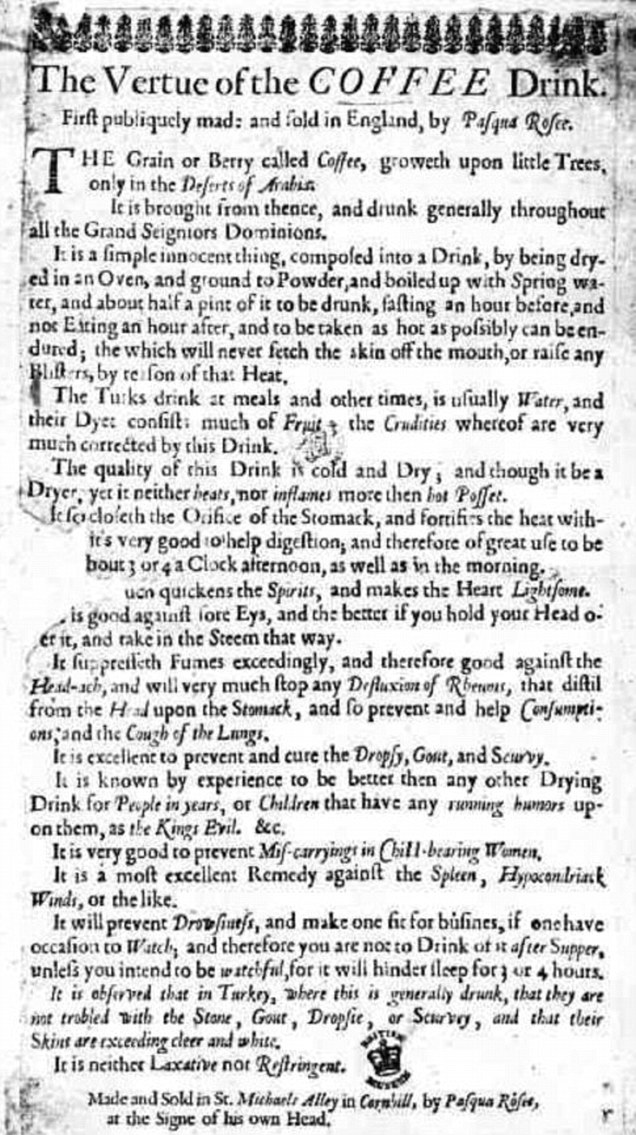
This advert with many claims such as ‘It is observed that in Turkey, where this is generally drunk, that they are not troubled by with the [gall] Stone, Gout, Dropsie, or Scurvy, and that their skins are exceedingly clear and white’, on display in the British Museum - dates back to the 1650s and was produced by Pasqua Rosee to promote his establishment possibly with the name of ‘Sign of his own head’ - possibly an allegory to ‘Turk’s head’?.
Further information courtesy of David Wilson:
Later in 1668 Edward Lloyd’s Coffee House in Tower Street becomes a key meeting place for shop owners and marine insurance brokers. Few London merchants had their own offices or counting-houses at this time. Instead, they transacted much of their business at the Royal Exchange, a meeting place in the City for businesses and merchants. News and information were collected in the social atmosphere of the coffee houses which became centres for specialised interests. Lloyd’s was fast attracting all those concerned with shipping and he fostered this interest by holding maritime auctions and collating information. This coffee house likely contributed to London becoming a global hub for insurance and financial services.

A painting from around 1668 showing patrons of Edward Lloyd’s Coffee House with what appears to be its ‘pulpit’.
Further reading: The Social Life of Coffee: The Emergence of the British Coffee House - Brian Cowan, Yale University Press, 2005

